tl;dr: For stereo audio input, mic input, and guitar input, there's nothing better. Sound quality is excellent, and the unit is physically solid—almost too solid!
[Update on iPhone 5 compatibility: Sonoma says the GuitarJack works like a champ with the iPhone 5 if you use one of Apple's 30-pin to lightning connectors.]
In my quest to find the killer solution for audio recording/input on my iOS devices, I've tested a ton of different external microphones and audio interfaces for the iPhone 4/4S, iPad, and iPod Touch. One class of device—a multi-channel input through the iPhone 4's dock connector—has been elusive until just recently, when three different devices were introduced a year after the iPhone 4:
- Fostex released the AR-4i (see my review of the AR-4i here), a worthy but flawed stereo audio interface,
- Tascam released the iM2 (which I haven't been able to review), a stereo microphone, and
- Sonoma Wireworks introduced the GuitarJack Model 2, which I am reviewing here.
Video Review
If this review is tl;dr for you, here's a video review that says almost everything, and gives three example sound clips at the end for your listening enjoyment (that is... if you like listening to my voice):
If Looks Could Kill...
...then my iPhone would most certainly be dead right now. The GuitarJack hardware is beautiful, simple, and perfect for its function. The gunmetal finish is very elegant (but fingerprint-prone), the weight of the object makes it feel like it won't break the first time I drop it, and the plugs are all extremely solid. Everything's metal here.
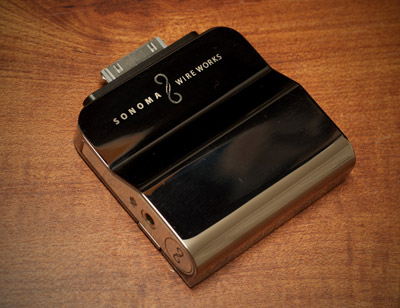
I'd always love a switch or two, and a gain knob on each input... but the GuitarJack, when paired with a great app like FourTrack, doesn't need such breakable (and space-consuming) frivolities. The GuitarJack was definitely designed for the hard life of a stage hand—I think it could be stepped on, thrown, and dropped on hard stage floors without as much as a dent.
The only concern I have on the hardware side is the dock connection; It's the sole projection from the sturdy metal of the GuitarJack, and it's like a thin, delicate wafer of metal with "break me" written all over it. Since the GuitarJack is relatively heavy, I wouldn't imagine shaking the iPhone or using the iPhone in motion (side to side or up and down) while the GuitarJack is connected.
However, my simple solution to this problem is the ever-so-handy blue tape applied across the top and bottom sides of the GuitarJack-to-iPhone void.
Making Connections
The GuitarJack has a 1/8" mono/stereo audio input on the left, a 1/8" headphone jack on the right, and a 1/4" guitar jack on the right. All three plugs are solid, easy to plug things into but secure enough that plugs won't fall out.
My favorite feature of the GuitarJack is the flexibility of all these inputs; through FourTrack and other supported apps, you can set padding or boosting and gain control on all the inputs in almost any configuration.
For example, I can plug in a Shure SM58 (one of my go-to vocal mics) to the left side mic input using a simple $5 XLR -> 1/8" adapter cable. Set the input to boost, and turn up the gain a little bit, and it's golden.
I can also plug a simple lavaliere microphone (like my favorite, the Audio-Technica ATR-3350 - $25 on Amazon) directly into the GuitarJack, set the input to boost, and adjust the gain appropriately, and it's golden.
I can plug a guitar with a pickup (or an amp) into the 1/4" jack on the right side of the GuitarJack, and the levels are perfect after a slight tweak to that input's gain in FourTrack's settings.
I can plug a stereo line output into the left mic jack on the GuitarJack, using a $2 stereo RCA -> 1/8" adapter. I set the input to pad, and adjusted the gain a little.
This audio interface is truly a swiss army knife for the iPhone 4, iPhone 4S, iPad and iPod Touch, when it comes to getting any kind of audio signal into the device!
It's All About the Sound – Quality
The sound quality of the GuitarJack Model 2 is excellent; much cleaner than the AR-4i, and definitely a lot cleaner than any mic connected through the iPhone's top headset jack (that input doesn't reproduce the full range of frequencies very well at all).
The analog-to-digital conversion in the GuitarJack is excellent, and allows for any level (mic or line, hi-z or lo-z, boosted or padded) to sound crisp and clean, with a very low noise floor.
Don't take my word for it, though! Here are a few sample recordings to show the sound quality (256 kbps MP3s):
- Shure PG48 XLR microphone into 1/8" mic input (00:41 - 1.3 MB)
- RadioShack 33-3013 Lavaliere microphone into 1/8" mic input (00:32 - 1 MB)
- Acoustic guitar into 1/4" line input (00:31 - .9 MB)
FourTrack - Professional Pocket Recording
FourTrack is a great companion app to FiRe 2 (my go-to app for standard audio recording), and luckily, both apps work great with the FourTrack, recording mono or stereo. FourTrack, though, was written by Sonoma Wireworks to take advantage of all the awesome features of the GuitarJack Model 2.
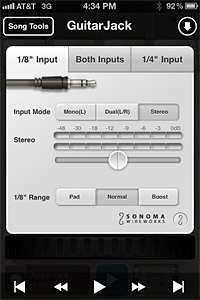
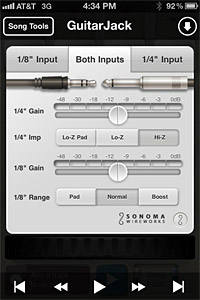
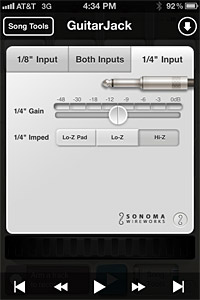
When you have the GuitarJack plugged into your iPhone, and you open FourTrack and visit the settings area, you can set tons of options for inputs, levels, etc., and select whatever recording setup you want:
- Stereo mic/line input through 1/8" minijack (with gain or padding)
- Mono mic/line input through 1/8" minijack + Mono lo-z or hi-z input through 1/4" guitar jack (with gain or padding)
- Mono lo-z or hi-z input through 1/4" guitar jack (with gain or padding)
It would be super-amazing if the GuitarJack would allow recording three tracks—stereo line in + guitar—but this is a limitation of the iPhone's dock connector (it only allows stereo in and stereo out).
FourTrack allows for easy recording of up to two channels at a time, and lets you quickly loop through recording a song or other track by recording one track, then a second, then a third, etc. It's perfectly-suited towards those who record music... and well-suited towards those (like me) who do more FX or voice work.
Luckily, my (current) favorite recording app (FiRe) also works fine recording two tracks (or one) with the GuitarJack, and other apps also work okay (including the venerable Voice Memos app that comes with the iPhone).
Not All Roses - Video Recording
There are also, unfortunately, many apps that don't work, or work erratically, with the GuitarJack. The built-in Camera app and FilMic Pro being the two most glaring omissions.
For some reason, the GuitarJack doesn't work as handily as something like the AR-4i when used with standard video recording apps, so either the sound goes away completely, the internal mic is used, or the sound is garbled and 'digital-ish' sounding when recording with one of the camera apps.
Sadly, this means that I won't be using the GuitarJack Model 2 (at this time, at least) when doing any video recording. I know the device isn't advertised as a video recording helper... but being able to use a stereo VideoMic with this hardware would be incredible while recording video!
One other quirk I noticed in my use of the GuitarJack was its tendency to switch off the iPhone 4S's 3G connection after being unplugged, if only for a few seconds... there is a problem like this with the AR-4i as well, so I'm wondering if the iPhone 4S itself has some sort of bug with the detaching of audio interfaces. I'm not usually making phone calls with the GuitarJack attached, and unplugging it during the call, so this isn't an issue in real-world usage.
Summary
The GuitarJack Model 2 is simply the best audio interface for the iPhone 4, iPhone 4S, iPad, and iPod Touch. As long as you don't need to use the interface for video (which I do, quite often), this will be one of the best purchases you can make for mobile (or even studio) audio recording.
Buy the GuitarJack Model 2 on Amazon.com for $130.
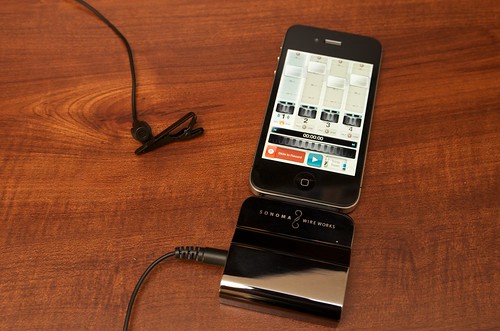
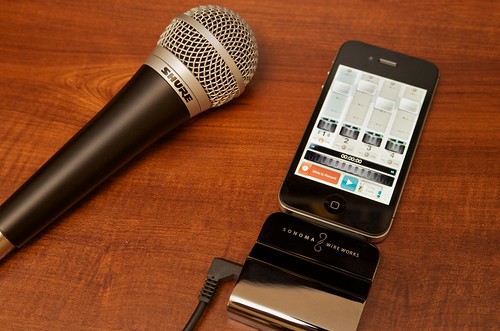
Comments
Jeff - thanks for taking the time to write up this excellent review. Definitely NOT tl;dr!
I was all ready to buy this until you mentioned that it doesn't work with the Camera app...which of course is exactly what I need it for: recording quality audio, from a stereo line out from my mixer, while shooting video with my iPhone 3GS.
Have you come across any solutions which would be applicable to my situation? Would love to hear if you have. Thanks again!
I know that for the 3GS, you used to be able to find some 3rd party dock connectors that had stereo line inputs, and it would work with the camera app. However, I can't find links to any of those connectors anymore, and my knowledge of 3GS-compatible devices for stereo line in is pretty thin.
I'm sure there's something out there, but my other favorite recommendation, the Fostex AR-4i, only works with the iPhone 4/4s :(
The Tascam iM2 would be perfect if it also included an input jack, but it does not.
Hey, thanks for the quick reply, Jeff. I did a little more searching yesterday, and so was ready for you to confirm that there doesn't seem to be anything out there for the 3gs anymore.
However, I also took a closer look at the KV Connection page, and now I'm wondering if maybe all I need is actually their RCA to 3.5mm TRRS adapter, since all I'm doing is sending stereo line level out from my mixer to the phone (again, using the Camera app). Do you know if this will work? Could it be that simple, or am I missing a step? Thanks again!
That will work fine for mono recording, but won't allow stereo recording, unfortunately. The headset input is one channel only.
Rats! Amazing that there isn't a simpler solution for this yet!
Thanks so much for putting all this info out there, though, and for all your responses to questions!
Jeff- Ive been tasked to record breakout sessions at a meeting. Im clearly technology challenged. I purchased 2 audio grabber mics from Martel Electronics. They told me simply plug them into headphone jack and daisy chain them and will work. It doesnt. 1st mic works and second does not. Would the Guitar Jack be a solution here to allow both mics to record so I can capture recording from both ends of the boardroom table? Appreciate your help.
The guitar jack would probably work for this, but I'm guessing that neither mic is actually working, and that your iPhone is still using its internal microphone even if you just have one mic plugged in.
You should try using the proper KVConnection audio adapter cable (probably the 1/8" microphone to iPhone TRRS connector), and see if that helps.
Whether it works depends on (a) the output impedance and level of the microphone you're using, and (b) which connectors the plug is using to send sound to your device. I'm guessing a KVConnection adapter will get the microphone working okay.
Hi jeff
Thanks for your great website, I have read this article with great interest. I am looking for a high quality way to record interviews using two mics and was slightly unclear if this can be done with the guitarjack? Any advice would be great thanks. Matt
You can; you can either plug one into left channel, one into right in the 1/8" mini jack, or you can plug a mono mic into the mini jack and another mono mic into the 1/4" phono jack. Then you configure the inputs/levels in the FourTrack app and record away.
This setup may not work as well in the built-in Camera app, though, so video interviews would be more difficult.
Jeff, I just recently bought an Iphone5 and love the video recording. I use ths for loud concerts. Do you have a recomendation if I use my phone for video recording, what mic or accessories can I get for stereo live concert recording? Is there any thing you recomend that is wireless? I need mics to be at times 15 feet from my IPhone . Check out alerttheglobe.com for what we are doing. Thank you very much, ron g
Jeff, regarding your post on the GuitarJack Mod.2. First, thanks for a very well developed review. I'm hoping you might share some insight for a related iPhone4, analog input setup. I'll just give you the bare bones of the signal path I want:
Korg PX4D Guitar Processor analog output. (stereo available)
into
iPhone 4, headphone/mic jack.
to
iPhone's Bluetooth output signal.
to
Bluetooth headphones. Thanks in advance for any council you can share.
Drew in Charleston, SC
Jeff, Just submitted a comment about Analog in to iphone4 and wanting Bluetooth output from iPhone4.
Should have indicated that I want this to be a "real time" path so I can use this, mainly, for headphone guitar sessions. Also, this "path" would not be using the GuitarJack device. Of course if it will work... I'll be able to drive other Bluetooth enabled equipment also. Thanks again for any guidance.